Vega: The North Star of the Past and the Future
Vega is a bright star located just 25 light-years from Earth, visible in the summer sky of the Northern Hemisphere. The star is part of the constellation Lyra and, with the stars Deneb and Altair, forms an asterism known as the Summer Triangle .
The star is only about 450 million years old, which makes it a youngster compared to our own solar system (which is 4.6 billion years old). Studies of Vega help astronomers learn more about solar systems that are in the early stages of their formation.
Because the Earth's axis wobbles, our perception of north gradually shifts to different stars over a 26,000-year cycle. Vega was the North Star several thousand years ago , and it will regain that status in about 12,000 years.

Locating Vega
Vega is almost directly overhead at midnorthern latitudes on midsummer nights. Vega sinks below the horizon for only 7 hours a day and can be seen on any night of the year.
Farther south, Vega lies below the horizon for a longer period, but in Alaska, northern Canada and much of Europe, Vega never sets. The star's location is:
- Right ascension: 18h 36m 56.3s.
- Declination: 38 degrees 47 minutes 01 second.
Early observations
Because Vega's blue-white light is so bright — the star has an apparent magnitude of 0.03 — it features prominently in ancient cultures, ranging from the Chinese to the Polynesians to the Hindus. Vega's name comes from the Arabic word " waqi ," which means "falling" or "swooping."
"This is a reference to the time when people regarded the constellation Lyra as a swooping vulture rather than a lyre," wrote Michael Anissimov on the website Wisegeek .
The name of Vega and those of other astronomical targets honor the traditional importance of astronomy in Islam , noted one researcher. Following the stars allowed believers to mark the times of prayer and festivals, as well as to find the holy city of Mecca.

"Thus, hundreds of stars and constellations have Arabic names, such as Altair, Deneb, Vega and Rigel," wrote Nidhal Guessoum, an astrophysicist at the American University of Sharjah in the United Arab Emirates, in a 2013 article published in the journal Nature .
In modern times, Vega was the first star to be photographed, other than the sun. Astronomers captured the image through the daguerreotype process at Harvard College Observatory, using a 15-inch (38 centimeters) refractor, on July 16-17, 1850.
The star was also chosen for the first spectrographic image , in 1872. amateur astronomer Henry Draper was the first to break down Vega's light to reveal the various elements that make up the star.
Vega in recent years
Vega rose to prominence in popular culture in the late 1990s after Carl Sagan's novel " Contact" (1985, Simon & Schuster) was adapted into a Hollywood movie . Starring Jodie Foster, the movie followed an astronomer working on the search for extraterrestrial intelligence (SETI) who discovers a signal appearing to emanate from Vega.
Telescopic observations in 2006 revealed that Vega is whipping around so quickly that its poles are several thousand degrees warmer than its equator . The star, which rotates every 12.5 hours, is at 90 percent of its critical rotation speed, or the velocity at which the object would tear itself apart.
In early 2013, astronomers announced that they had discovered an asteroid belt surrounding Vega , suggesting the possibility of planets within the rocks' midst. The layout (which resembled that found near the star Fomalhaut) suggests that there are two areas: an outer region with icy asteroids and a region closer to the star, where warmer space rocks reside.
Scientists are examining bright stars like Vega more closely using NASA's TESS (Transiting Exoplanet Survey Satellite) mission, which launched in 2018 to conduct an all-sky survey. While the primary mission of TESS is to search for exoplanets, the satellite will also search for signs of star variability. TESS's examination of Vega and similar stars will help scientists learn more about the early stages of star evolution.
Join our Space Forums to keep talking space on the latest missions, night sky and more! And if you have a news tip, correction or comment, let us know at: [email protected].
Get the Space.com Newsletter
Breaking space news, the latest updates on rocket launches, skywatching events and more!
Elizabeth Howell (she/her), Ph.D., is a staff writer in the spaceflight channel since 2022 covering diversity, education and gaming as well. She was contributing writer for Space.com for 10 years before joining full-time. Elizabeth's reporting includes multiple exclusives with the White House and Office of the Vice-President of the United States, an exclusive conversation with aspiring space tourist (and NSYNC bassist) Lance Bass, speaking several times with the International Space Station, witnessing five human spaceflight launches on two continents, flying parabolic, working inside a spacesuit, and participating in a simulated Mars mission. Her latest book, " Why Am I Taller ?", is co-written with astronaut Dave Williams. Elizabeth holds a Ph.D. and M.Sc. in Space Studies from the University of North Dakota, a Bachelor of Journalism from Canada's Carleton University and a Bachelor of History from Canada's Athabasca University. Elizabeth is also a post-secondary instructor in communications and science at several institutions since 2015; her experience includes developing and teaching an astronomy course at Canada's Algonquin College (with Indigenous content as well) to more than 1,000 students since 2020. Elizabeth first got interested in space after watching the movie Apollo 13 in 1996, and still wants to be an astronaut someday. Mastodon: https://qoto.org/@howellspace
Is there liquid water on Mars today? Marsquake data could tell us
Ed Stone, who led NASA's iconic Voyager project for 50 years, dies at 88
See a starburst galaxy, ablaze with explosive star birth, devouring dwarf galaxies (video)
Most Popular
- 2 Borderlands games ranked, worst to best
- 3 NASA dips into futuristic AR tech to build powerful Roman Space Telescope
- 4 Take a deep dive into UFO history in 'After the Flying Saucers Came' by Greg Eghigian (exclusive)
- 5 What happened to China's Chang'e 6 lander on the moon's far side?
Vega Star Facts – The Brightest Star in Lyra Constellation
Vega is one of the most studied stars, which still has enough to surprise us. In this article, you will learn how to spot Vega in the sky and explore what makes it such a fascinating object of study.
Why is Vega so important?
Is vega the brightest star in the sky, vega star color, how old is vega, how fast does vega spin, where is vega in the sky tonight, how to find vega star – the summer triangle star, how to locate vega with the sky tonight app, arabic name – falling eagle, greek myth – the harp star, love story of altair and vega, the first star to be photographed, vega may have a planet, our past and future north star, waymark to the lyrid meteor shower, bottom line.
For thousands of years, the star Vega has been observed by humans, with records found in ancient Chinese, Arabic, and Greek astronomy. In recent history, astronomers chose it as a reference point for measuring other stars’ color and apparent brightness. Today, scientists are studying Vega to learn about the early stages of stellar evolution and to search for exoplanets. As a bonus, Vega will be the next brightest Polar Star . Read on to find out some of its main features.
Vega (Alpha Lyrae) – key star facts
- Official name : Alpha Lyrae, α Lyr
- Alternative names : Wega, Alf Lyr, Al-Waqi'
- Catalog designations : HIP 91262, HR 7001, HD 172167, TYC 3105-2070-1
- Constellation : Lyra
- Star type : class A0V main-sequence star
- Right ascension : 18 h 36 m 56.3 s
- Declination : +38° 47′ 01″
- Mass : 2.1 solar masses
- Luminosity : 40.12 L (37 times brighter than the Sun)
- Radius (polar/equatorial) : 1.64 million km (1.02 million miles) / 1.96 million km (1.22 million miles), or 2.362 / 2.818 solar radius
- Temperature : 9,600 K
- Distance from the Earth : 25 light-years
- Rotation period : 12.5 hours
No, the brightest star in the night sky is Sirius . In the Northern Hemisphere, Vega is the 3rd brightest star, after Sirius in Canis Major and Arcturus in Bootes. Considering the entire night sky, it gives way to Canopus in Carina and Alpha Centauri in Centaurus. This makes it the 5th brightest star in all.
If you check Vega’s apparent brightness in a stargazing app like Sky Tonight , you’ll see that its magnitude equals zero. However, this doesn't mean Vega has no brightness. It means that it serves as the zero point for a scale of stellar magnitudes that includes positive and negative numbers. Vega was used as an absolute reference for the magnitudes of other stars until the late 20th century. Today, more precise calculations show Vega’s magnitude as +0.026, but it’s still rounded to zero for amateur observations.
Watch our short video tutorial to learn how to explore the characteristics of the stars and other celestial objects in Sky Tonight .
The apparent brightness of the stars depends on their size, temperature, and distance from us. Vega hit the jackpot: it’s so bright because it's big, hot, and close to the Earth. Vega has a diameter of about 2.8 times that of the Sun and a surface temperature of more than 1.5 times that of the Sun. It is also located about 25 light-years from the Earth – a very close neighborhood for a star.
Get to know all the brightest stars in the sky with our colorful infographic .

Vega is a bluish-white star classified as A0V:
- The letter “A” denotes its surface temperature of about 10,000 K.
- The number 0 indicates that it’s the hottest among the 10 subclasses in its spectral type.
- The letter “V” indicates that it’s a main sequence star going through its main phase of life as it fuses hydrogen into helium.
Vega is traditionally the zero point for the color index in the UBV system . The zero point in the system is “white”; stars with negative color indexes are called “blue,” and those with positive indexes are “red.” But if so, why do we say Vega is bluish-white instead of pure white? The reason is that the spectral characteristics of the stars don’t consider illumination conditions in the Earth’s atmosphere, so its bluish tint is due to how our atmosphere affects the light we see.
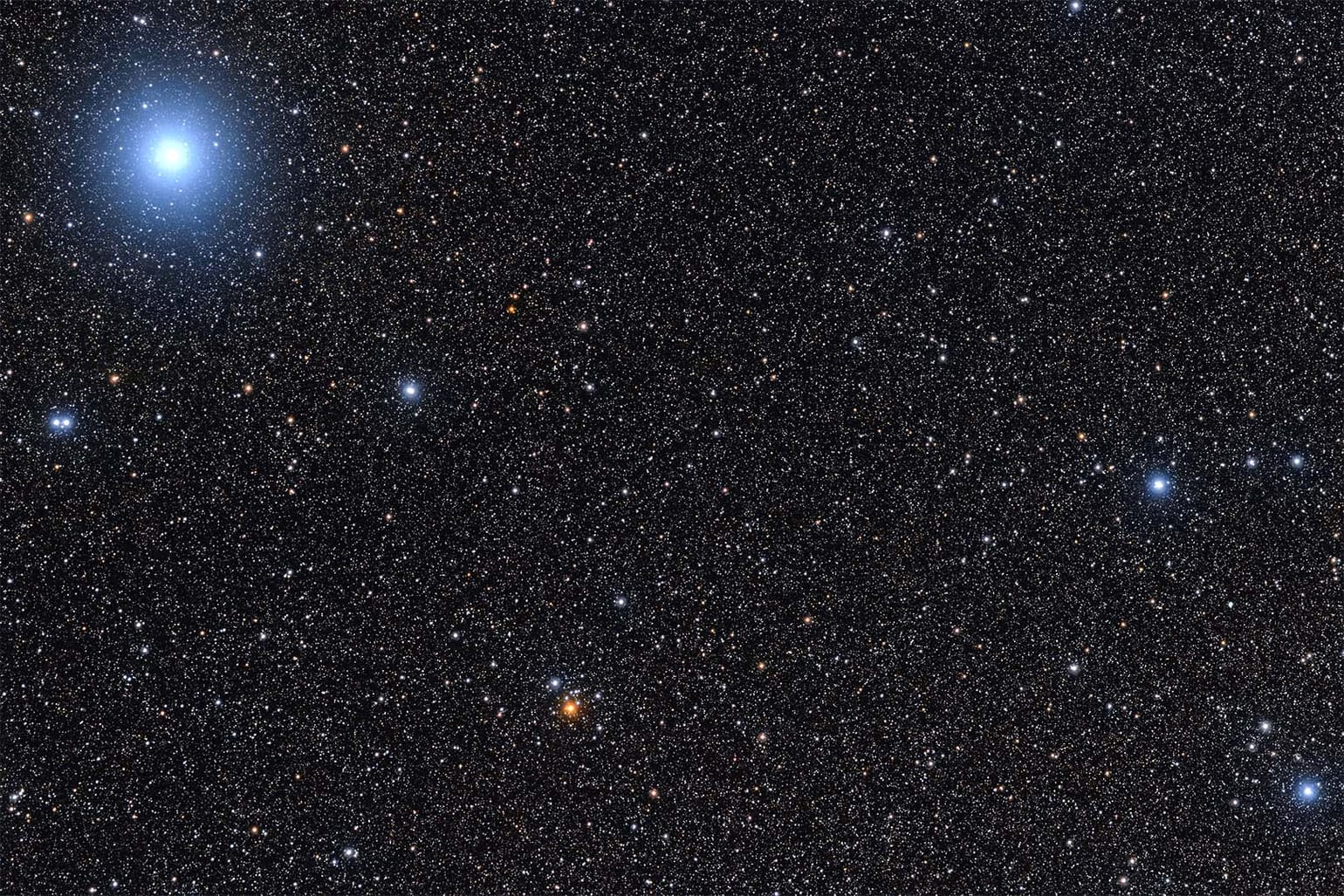
Vega is about 455 million years old. That’s one-tenth the age of the Sun, but it’s aging much faster. Both stars are already in the middle of their main-sequence lifespan, but Vega is expected to burn out in the next 450 million years, while our Sun will survive for another 4.5 billion years.
Vega rotates on its axis about once every 12.5 hours. By comparison, the Sun takes 27 days to complete a full rotation. Spinning so fast makes Vega cooler and wider at its equator.

Where is the star Vega – constellation Lyra
Vega is the brightest star of the Lyra constellation, one of the smallest constellations in the night sky. It is also part of a larger asterism known as the Summer Triangle. It’s easy to find Vega and other stars with stargazing apps like Sky Tonight . Read on to get the step-by-step guide.
Vega can be observed almost directly overhead during midsummer nights at mid-northern latitudes. At other times of the year, it’s still visible at night in the Northern Hemisphere but stays lower above the horizon. In the Southern Hemisphere, the star appears low in the northern sky, visible from April to late September.
To find Vega in the sky, look for the Summer Triangle , a prominent asterism made up of Vega in Lyra, Altair in Aquila, and Deneb in Cygnus. Vega is the brightest of the three and can be seen as a bright bluish-white star. In the summer of the Northern Hemisphere, it rises in the east right after it gets dark. It’s hard to confuse it with anything else because Vega is the brightest star in that direction. Once you’ve found it, look to the lower right for Altair and to the lower left for Deneb. In the Southern Hemisphere, the Triangle will appear upside down, rising low on the northern horizon.
Check out our easy-to-find stars infographic for a visual representation.

You can quickly locate Vega with the help of the stargazing app Sky Tonight by following these simple steps:
- Open the app’s search bar and type “Vega.”
- Tap the blue target button to the right of the matching result. The app will show you the star's position on the sky map.
- Tap the blue compass button at the bottom right of the screen. The app will use your device’s location to align the screen image with the real sky above you.
- Move your device following the white arrow until you see Vega on the screen and in the real sky.

Vega was mentioned in many ancient myths, including Chinese, Japanese, Indian, Greek, and Arabic. Some of these myths have left their marks on the name of the star and its constellation.
The name Vega came from the Bedouin Arabic expression “an-nasr al-wāqi',” meaning “the swooping eagle or vulture,” where “wāqi'” refers to “falling” or “swooping.” Along with its partner, Altair, known as “the flying eagle or vulture,” Vega was famous in Arabian astronomy since the early 6th century CE . They were mentioned in various texts and poetry.
The ancient Greeks called Vega and its constellation “Lyra” or “the Harp.” According to the myth, this celestial lyre was a musical instrument belonging to Orpheus, the legendary musician. After Orpheus was killed, Zeus sent an eagle (Aquila) to retrieve the harp, and both were placed in the sky.
A celestial couple of Altair and Vega inspired beautiful love stories in Chinese, Japanese, and Korean cultures. In Chinese folklore, Altair represents Niulang, a cowherd, and Vega represents Zhinü, the weaving girl. The two fell in love but were separated by the Milky Way, or Celestial River, and were only allowed to meet once a year on the seventh day of the seventh lunar month at the time of the Qixi Festival. In a similar Japanese legend, the couple was allowed to reunite once a year during the Tanabata festival. And in the Korean version, the lovers reunite once a year during the Chilseok festival.

Fun star facts about Vega
On July 17, 1850, Vega became the first star other than our Sun to be photographed. Astronomers James Adams Whipple and William Cranch Bond captured the star using the daguerreotype technique. They focused Vega's light on a photosensitive silver-plated copper sheet and exposed it for about 20 minutes using the 15-inch refractor at Harvard College Observatory.
Over two decades later, in August 1872, the star made history again. This time, amateur astronomer Henry Draper photographed Vega's spectrum. The breakdown of Vega's light into its component colors helped scientists reveal its chemical composition.

In recent years, astronomers discovered that Vega may have a large asteroid belt similar to our own Solar System’s Asteroid and Kuiper belts . The data revealed two distinct belts around Vega: a warm inner belt and a cool outer belt, with a gap in between. Scientists believe that this gap could be home to multiple planets orbiting the star.
A study published in The Astronomical Journal suggests that evidence has been found for at least one such planet. This planet is believed to be as large as Neptune or Uranus and as close as Mercury to our Sun. Moreover, it’s supposed to be incredibly hot, with a temperature of 2,977 °C (5,390 °F), making it the second-hottest discovered planet. However, further research is needed to confirm these findings.
Our modern Polaris seems motionless, but it slowly shifts across the sky in a circuit that takes about 26,000 years, giving way to other stars near the north celestial pole. This motion is due to the precession of the Earth's axis . Around 12,000 BCE, the Paleolithic people observed Vega as the North Star instead of Alpha Ursae Minoris . And in the future, by around 13,600, Vega will become the North Star again.
Vega is a reference point to see one of the prolific meteor showers – April Lyrids . The star shines near the shower’s radiant, so check that it’s high above the horizon to determine the ideal time for catching the “shooting stars.”
Vega is one of the brightest stars in the sky and plays a unique role in astronomy. For a long time, it was the absolute reference for the brightness and color of stars, and now it continues to be studied because it may have a planet. In 13,000 years, it will be the new North Star, the brightest of the following millennia. Get to know this brilliant star better and find it in the sky above you with the help of Sky Tonight !

- [ November 30, 2022 ] The Night Sky This Month: December 2022 Night Sky
- [ November 22, 2022 ] James Webb Telescope Turns Its Attention To The Kuiper Belt News & Events
- [ November 1, 2022 ] The Night Sky This Month: November 2022 Night Sky
- [ October 4, 2022 ] Are Wormholes Fact or Fiction? General Astronomy
- [ October 1, 2022 ] The Night Sky This Month: October 2022 Night Sky
Star Facts: Vega
March 3, 2016 James Miller Stars 0

Vega (Alpha Lyrae) is a beautiful bluish-white star located 25 light-years away in the constellation of Lyra. In addition to being the fifth brightest star in the night sky, it has other claims to fame, not least of which is it being the first star other than the Sun to have its picture taken, the very first star to have its spectrum recorded, and among the first stars to have its distance from Earth calculated by parallax. Furthermore, Vega was also once the Pole Star , and it will be again in about the year 13,727, when its declination will be +86°14′.
Quick Facts
• Constellation: Lyra • Coordinates: RA 18h 36m 56.33635s|Dec +38° 47′ 01.2802″ • Distance to Earth: 25.04 light years • Star Type: Blue/White Main Sequence (A0Va) • Mass: 2.135 solar masses • Radius: 1.961 million km (2.362 solar radii) • Apparent Magnitude: +0.03 • Luminosity: 40.12 solar luminosities • Surface Temperature: 10,060 K • Rotational Velocity: 20.48 km/s • Age: 455 million years • Other Designations: Wega, Lucida Lyrae, Alpha Lyrae, a Lyrae, 3 Lyr,
In both ancient Egypt and India, the constellation Lyra was represented as either an eagle or a vulture, and it is from these cultures that Vega appeared in the western world under its Arabic name “an-nasr al-waqi” meaning “the swooping eagle”. The first mention of Vega in an official Western star catalogue was in the Alfonsine Tables of 1215, and in medieval England and Western Europe, Vega was known as either Wega or Alvaca.
Physical Properties
Vega is a blue-white (A0V) main sequence star, only halfway through its one billion-year stellar life cycle , and still in the process of fusing hydrogen into helium. It is about 40 times more luminous than the Sun as it is using up its hydrogen fuel about ten times faster. Vega is also about 2.1 times more massive than our sun, but only 0.54% of its total mass consists of elements heavier than helium, making it a weak Lambda Boötis-type star.

Vega is part of an asterism of stars called the Summer Triangle, which consists of Vega in the constellation Lyra, Altair in Aquila, and Deneb in Cygnus. However, Vega can only be seen at latitudes north of +51° N, where the constellation never sets below the horizon, and remains a circumpolar star throughout the year. Look for Vega as the star at the right-angled corner of the Summer Triangle around the first of July when it culminates as it crosses the meridian.
Vegas is rotating at 236.2 km/sec at its equator, making it a very fast rotator indeed. This value translates into one rotation once every 12.5 hours, which represents 87.6% of the velocity it would take for the star to fly apart as the result of excessive centrifugal forces. Such fast rotation means that the star’s equatorial radius is 19% bigger than its polar radius, producing a pronounced equatorial bulge. Current measurements put the star’s equatorial radius at 2.818 solar radii, and its polar radius at only 2.362 solar radii. Interestingly, the unexpected high luminosity of Vegas (40 times solar) is explained by the effects of the high differential rotation on its magnetic field, which produces the higher luminosity of the polar region.
Castor Moving Group Origins
Vega appears to belong to a stellar association known as the Castor Moving Group, along with other major stars like Alpha Librae, Alpha Cephei, Castor, Fomalhaut, and about a dozen or so others. It is assumed that since the members of the group are all moving in roughly the same direction, and at about the same speed, (16.5 km/sec), all the members have a common origin in an open cluster that has become gravitationally unbound. However, there is some doubt about this because Vega is significantly older than the other stars in the group, which are estimated to be only about between 100 million and 300 million years old, making them all very much younger than Vega. Moreover, the scarcity of heavy elements in Vega implies that it was formed from material that was relatively metal-poor, but its origin remains uncertain.
Related Posts
© Copyright 2023 Astronomy Trek
Vega Star Facts on Our Future North Star
- An Introduction to Astronomy
- Important Astronomers
- Solar System
- Stars, Planets, and Galaxies
- Space Exploration
- Weather & Climate
- Ph.D., Biomedical Sciences, University of Tennessee at Knoxville
- B.A., Physics and Mathematics, Hastings College
Vega is the fifth-brightest star in the night sky and the second-brightest star in the northern celestial hemisphere (after Arcturus). Vega is also known as Alpha Lyrae (α Lyrae, Alpha Lyr, α Lyr), as it is the principle star in the constellation Lyra, the lyre. Vega has been one of the most important stars to humanity since ancient times because it is very bright and easily recognized by its blue color.
Vega, Our Sometime North Star
The Earth's axis of rotation precesses, like a wobbling toy top, which means "north" changes over a period of around 26,000 years. Right now, the North Star is Polaris, but Vega was the northern pole star around 12,000 BC and will the pole star again about the 13,727. If you took a long exposure photograph of the northern sky today, the stars would appear as trails around Polaris. When Vega is the pole star, a long exposure photograph would show stars circling it.
How to Find Vega
Vega is seen in the summer sky in the Northern Hemisphere, where it is part of the constellation Lyra. The " Summer Triangle " consists of the bright stars Vega, Deneb, and Altair. Vega is at the top of the triangle, with Deneb below it and to the left and Altair below both stars and to the right. Vega forms a right angle between the two other stars. All three stars are extremely bright in a region with few other bright stars.
The best way to find Vega (or any star) is to use its right ascension and declination:
- Right Ascension: 18h 36m 56.3s
- Declination: 38 degrees 47 minutes 01 second
There are free phone apps that you can use to seek Vega by name or by its location. Many allow you to wave the phone across the sky until you see the name. You're looking for a bright blue-white star.
In northern Canada, Alaska, and most of Europe, Vega never sets. In the mid-northern latitudes , Vega is almost directly overhead at night in mid-summer. From a latitude including New York and Madrid, Vega is only below the horizon about seven hours a day, so it can be viewed any night of the year. Further south, Vega is below the horizon more of the time and may be trickier to find. In the Southern Hemisphere, Vega is visible low on the northern horizon during the Southern Hemisphere's winter. It is not visible south of 51° S, so it cannot be seen at all from the southern part of South America or Antarctica.
Comparing Vega and the Sun
Although Vega and the Sun are both stars, they are very different from one another. While the Sun appears round, Vega is noticeably flattened. This is because Vegas has over twice the mass of the Sun and is spinning so rapidly (236.2 km/s at its equator), that it experiences centrifugal effects. If it were spinning about 10% faster, it would break apart! The equator of Vega is 19% bigger than its polar radius. Because of the star's orientation with respect to Earth, the bulge appears unusually pronounced. If Vega was viewed from above one of its poles, it would appear round.
Another obvious difference between Vega and the Sun is its color. Vega has a spectral class of A0V, which means it is a blue-white main-sequence star that fuses hydrogen to make helium. Because it is more massive, Vega burns up its hydrogen fuel more quickly than our Sun, so its lifetime as a main-sequence star is only about one billion years, or about a tenth as long as the Sun's life. Right now, Vega is about 455 million years old or half-way through its main-sequence life. In another 500 million years or so, Vega will become a class-M red giant, after which it will lose most of its mass and become a white dwarf.
While Vega fuses hydrogen , most of the energy at its core comes from the carbon-nitrogen-oxygen (CNO cycle) in which protons combine to form helium with intermediate nuclei of the elements carbon, nitrogen, and oxygen, This process is less efficient than the Sun's proton-proton chain reaction fusion and requires a high temperature of about 15 million Kelvin. While the Sun has a central radiation zone at its core covered by a convection zone , Vega has a convection zone at its core that distributes ash from its nuclear reaction. The convection zone is in equilibrium with the star's atmosphere.
Vega was one of the stars used to define the magnitude scale , so it has an apparent magnitude around 0 (+0.026). The star is about 40 times brighter than the Sun, but because it's 25 light-years away, it seems dimmer. If the Sun was viewed from Vega, in contrast, its magnitude would only be a faint 4.3.
Vega appears to be surrounded by a disk of dust. Astronomers believe the dust may have resulted from collisions between objects in a debris disk. Other stars that display excessive dust when viewed in the infrared spectrum are called Vega-like or Vega-excess stars. The dust is found mainly in a disk around the star rather than a sphere, with particle sizes estimated to be between 1 to 50 microns in diameter.
At this time, no planet has been definitively identified orbiting Vega, but its possible terrestrial planets could orbit near the star, probably in its equatorial plane.
Similarities between the Sun and Vega are that they both have magnetic fields and sunspots .
- Yoon, Jinmi; et al. (January 2010), "A New View of Vega's Composition, Mass, and Age", The Astrophysical Journal , 708 (1): 71–79
- Campbell, B.; et al. (1985), "On the inclination of extra-solar planetary orbits", Publications of the Astronomical Society of the Pacific , 97 : 180–182
- Explore a Celestial Triangle
- The Ever-changing North Pole Star
- How to Find the Lyra Constellation in the Night Sky
- The 10 Brightest Stars in the Sky
- Stargazing Through the Year
- A Gallery of Constellation Pictures
- Sun Facts: What You Need to Know
- Deciphering Star Charts for Skygazing
- Journey Through the Solar System: Our Sun
- Exploring the Carina Nebula
- How to Find the Boötes Constellation
- How to Find the Capricornus Constellation
- How to Spot the Cassiopeia Constellation in the Night Sky
- How to Find the Phoenix Constellation
- What are Hypergiant Stars Like?
- The Big Dipper
Exceptionally Preserved Fossils Reveal 3D Anatomy of Cambrian Trilobites
Researchers identify cryptic new species of armadillo.
- New Bird Species Discovered in Brazil
- 3,300-Year-Old Shipwreck Loaded with Canaanite Amphorae Discovered in Mediterranean Sea
- New Species of Horned Dinosaur Had Unusual, Curving Blade-Like Horns on Back of Its Frill
- Paleontologists Discover New Bird-Like Dinosaur in Argentina
- Unique Nothosaur Fossil Unearthed in New Zealand

Massive Exoplanet Candidate Spotted around Vega
Astronomers have discovered evidence for a giant planet orbiting Vega , a young star located 25 light-years away in the constellation of Lyra.

An artist’s impression of a massive planet around Vega. Image credit: Fossart / CC BY-SA 4.0.
“Scientists can also see Vega with telescopes even when it’s light out, which makes it a prime candidate for research,” said Dr. Samuel Quinn , an astronomer at the Harvard and Smithsonian Center for Astrophysics.
“It’s bright enough that you can observe it at twilight when other stars are getting washed out by sunlight.”
“It would be really exciting to find a planet around Vega because it offers possibilities for future characterization in ways that planets around fainter stars wouldn’t,” he added.
Vega is an A-type star, the name for stars that tend to be bigger, younger and much faster-spinning than the Sun.
Also known as Alpha Lyra, Gliese 721 and HD 172167, the star is 455 million years old, and has a mass of two solar masses.
It rotates around its axis once every 16 hours — much faster than the Sun with a rotational period that clocks in at 27 Earth days.
“Such a lightning-fast pace can make it difficult for scientists to collect precise data on the star’s motion and, by extension, any planets in orbit around it,” Dr. Quinn said.
In the study, Dr. Quinn and colleagues analyzed 1,524 spectra of Vega collected by the Fred Lawrence Whipple Observatory during 10 years.
They detected a candidate radial-velocity signal with a period of 2.43 days.
If caused by an orbiting planet, its minimum mass would be 20 Earth masses. Because of Vega’s pole-on orientation, this would correspond to a Jovian planet if the orbit is aligned with the stellar spin.
“It would be at least the size of Neptune, potentially as big as Jupiter and would be closer to Vega than Mercury is to the Sun,” said Spencer Hurt , an undergraduate student in the Department of Astrophysical and Planetary Sciences at the University of Colorado Boulder.
“That close to Vega the candidate world might puff up like a balloon, and even iron would melt into gas in its atmosphere.”
The candidate planet, Vega b, could also rank as the second hottest world known to science — with surface temperatures averaging a searing 2,980 degrees Celsius (5,390 degrees Fahrenheit).
“This is a massive system, much larger than our own Solar System,” Hurt said.
“There could be other planets throughout that system. It’s just a matter of whether we can detect them.”
The results were published in the Astronomical Journal .
Spencer A. Hurt et al . 2021. A Decade of Radial-velocity Monitoring of Vega and New Limits on the Presence of Planets. AJ 161, 157; doi: 10.3847/1538-3881/abdec8

NASA Release 3D Visualization of ‘Pillars of Creation’

Astronomers Observe Starburst Galaxy NGC 4449

Astrobiologists Identify Five Greenhouse Gases that Would Be Giveaways of Terraformed Exoplanet

IXPE Discovers New Ultra-Luminous X-ray Source in Milky Way

Webb Observes Intricate Structures in Ionosphere of Jupiter

The Nine Planets
Vega (α Lyrae) Facts
Vega is only 25 light-years away from the sun. it has a tenth of the age of our sun, and it is 2.1 times more massive..
Vega is the brightest star in the northern constellation of Lyra. It is the fifth-brightest star in the night sky.
Key Facts & Summary
- It was the northern pole star until 12.000 BC, this led to its great importance for ancient civilizations, and astronomers termed it “the second most important star, after the Sun.”
- It is the second star to be photographed, and the first to have its spectrum recorded. It was photographed in 1850.
- Vega is only 25 light-years away from the Sun.
- It has a tenth of the age of our Sun, and it is 2.1 times more massive.
- Vega is a variable star thus it changes its brightness
- Our Sun rotates on its axis in about 28 days, Vega, on the other hand, rotates much faster – once every 12 and a half hours, with a speed of 236 km/ 146.6 mi per second at the equator.
- Because of Vega’s fast rotation, the star is bulged at the equator and results in different temperatures across the star’s photosphere. The maximum temperatures are present only at the poles.
- From Earth, Vega is viewed from the direction of one of these poles.
- The star appears to have a circumstellar disk of dust around it, most probably due to collisions.
- Vega is also one of the first stars to have its distance estimated through parallax measurements.
- It appears that the star has a low abundance of elements, with a higher atomic number than that of helium.
- Vega will become yet again the northern pole star, but this will happen in the year 13.727.
- Vega has only 500 million years since it took form. It is believed that the star’s lifespan is around 1 billion years or one-tenth that of our Sun.
- The star can be seen with the naked eye with an apparent magnitude of 0.03, and it varies from 0.127 to 0.068.
- Vega is also known as Alpha Lyrae since it’s one of the brightest stars in the Lyra constellation.
Vega’s original name, Wega, was derived from a loose transliteration of wāqi‘ , which means “falling” or “swooping” in Arabic.
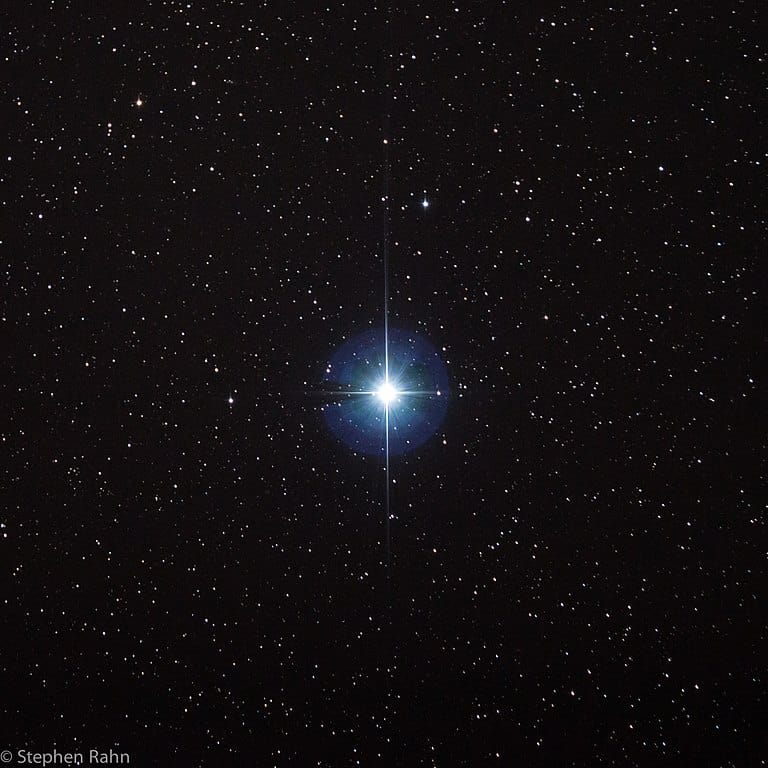
The star was very important to the ancient people as it was once our north star. This was around 12.000 BC, all-stars appeared to move towards it. The reason for this was that our Earth wobbles as it spins on its daily axis. It makes one complete wobble every 25.770 years. At this moment, the spin axis of Earth is pointing towards Polaris. Around 14.000 years ago, it was pointing towards Vega.
In 1850, Vega became the second star to be photographed by William Bond and John Adams. Henry Draper took the first photograph of a star’s spectrum in 1872 when he took an image of Vega.
Since 1943, the spectrum of Vega served as one of the stable anchor points by which other stars are classified. In 1979, Vega became the first solitary main-sequence star beyond the Sun known to be an X-ray emitter. Later, in 1983 Vega became the first star found to have a disk of dust.
Distance, Size, and Mass
Vega is about 25 light-years away from the Sun, and it lies at a vertex of a widely spaced asterism called the Summer Triangle. It consists of Vega and two first-magnitude stars Altair, in Aquila, and Deneb in Cygnus. This formation is the approximate shape of a triangle.
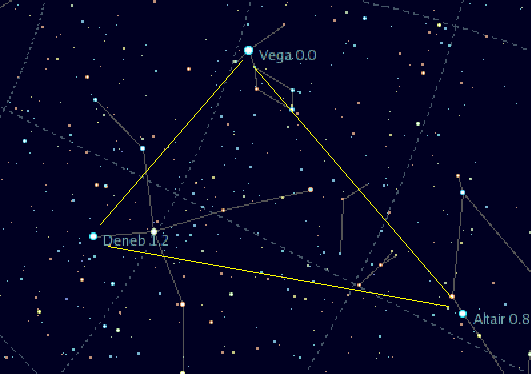
Vega has a radius of around 1.1 million mi / 1.8 million km, about 2.5 times bigger than our Sun. The mass has been estimated to be around 2.1 that of our Sun.
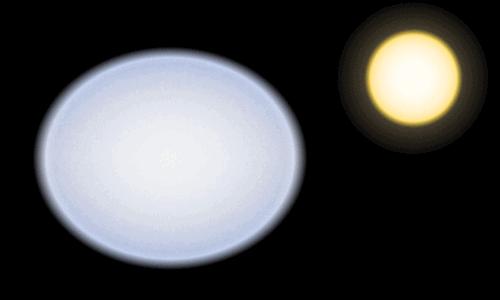
Because Vega has such a mass, its fusion fuel will deplete more quickly than smaller stars.
Vega has a photosphere metallicity of only about 32% of the abundance of heavy elements found in the Sun’s atmosphere. About 0.54% of Vega consists of elements heavier than helium. This chemical peculiarity suggests that Vega formed from an interstellar medium of gas and dust that was unusually metal-poor about 500-800 billion years ago.
Vega has a very rapid rotation. It rotates once every 12.5 hours, with a speed of 236 km/ 146.6 mi per second, at the equator. This produces a pronounced equatorial bulge, so the radius of the equator is 19% larger than the polar radius. Because of this, the polar regions are near 10.000 K in temperature, while the equatorial temperature is about 8.152 K.
Characteristics
Vega is a white main sequence star – A-Class. It is almost twice as hot as the Sun, and its luminosity is about 40 times greater than that of our Sun. Since it is enveloped by a disc of dust, it may indicate that planet-forming activity is or has taken place.
The star will become a red giant in around half a billion years when it can no longer fuse hydrogen at its core. Vega showed occasional low-amplitude pulsations associated with a Delta Scuti variable. This category of stars has periodic pulsations in their luminosity. It radiates much more ultraviolet wavelengths than our Sun. A key feature is its bulging equator due to great rotational speeds.
Star System
There are about 8 or more stars near Vega at a distance of 10 light-years. The most interesting part of Vega is its disc of dust similar in some ways to our Solar System’s Kuiper Belt. This disk extends up to 330 to 815 AU.

Some perturbations in the dust disk have led to the hypothesis that Vega may actually have planets orbiting it or other large celestial objects. Calculations estimated that an object with about 12 times the mass of Jupiter could explain these perturbations.
Theories state that this dust disk may have formed after two planets similar in size to Pluto, may have collided and resulted in the debris. Others believe that this disc is, in fact, a planetary system still undergoing formation. Observations continue in the hope of finding such celestial objects.
Vega is the brightest star in the northern constellation of Lyra. Together with Arcturus and Sirius, it is one of the most luminous stars in the Sun's neighborhood. It is the fifth-brightest star in the night sky and the second-brightest star in the northern celestial hemisphere after Arcturus.
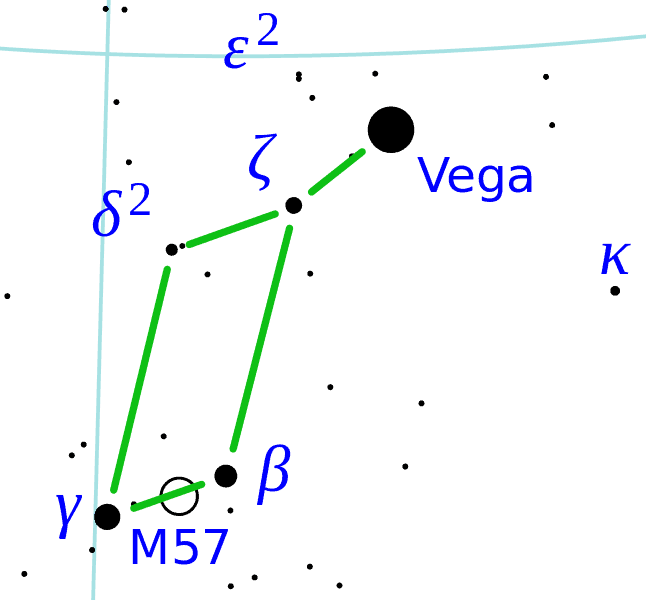
Vega will turn into an M-class Red Giant in about half a billion years, and then it will eventually turn again, but this time into a white dwarf. In around 10.000 years it will replace Polaris as the northern pole star.
Did you know?
- Stars that display an infrared excess due to dust emission are termed Vega-like stars.
- We, along with the entire solar system, are moving towards Vega at a speed of 15 mi / 24.1 km per second. Because of this, Vega will become the brightest star in the sky in about 210.000 years. This will cause Vega’s magnitude to reach its peak at around -0.81 in roughly 290.000 years. Even after it will reach that point, it will remain the brightest star seen from Earth for another 270.000 years.
- Vega is associated with the Lyrid meteor shower which peaks near the end of April every year. These meteors appear to originate from the direction of Vega, however, it is not physically associated with the star of its constellation.
- It is the first star to have a car named after it with the French Facel Vega line of cars from 1954 onwards, and then in America, Chevrolet launched the Vega car in 1971.
- The constellation of Lyra was represented as a vulture in ancient Egypt, and India.
- When Vega set below the horizon, it signaled the start of autumn for the Romans.
- In Zoroastrianism, Vega was associated with Vanant, a minor divinity whose name means “conqueror.”
Image source:
- https://upload.wikimedia.org/wikipedia/commons/thumb/a/ad/Vega_by_Stephen_Rahn.jpg/768px-Vega_by_Stephen_Rahn.jpg
- https://upload.wikimedia.org/wikipedia/commons/0/0f/Summer_triangle.png
- https://upload.wikimedia.org/wikipedia/commons/c/c8/Size_Vega.png
- https://www.nasa.gov/sites/default/files/images/717860main_pia16611_full.jpg
- https://upload.wikimedia.org/wikipedia/commons/thumb/9/9d/Vega_in_lyra.svg/646px-Vega_in_lyra.svg.png

Order Your Almanac Today!
10 Facts About Vega, Summer's Bright Star

Image Credit & Copyright: Steed Yu & NightChina.net

Look for the Bright Star Vega in July!
In early summer, night falls at its latest hour—around 9:30 to 10 PM . High in the east shines summer’s bright star—the famous Vega. Learn fascinating facts about Vega, a favorite of stargazers and astronomers, and its fascinating folklore.
Away from city lights in mid-July, one could see as many as 2,500 naked-eye stars. But if you look east, only one star stands out because it’s the only bright star overhead—Vega.
1. Vega of The Summer Triangle
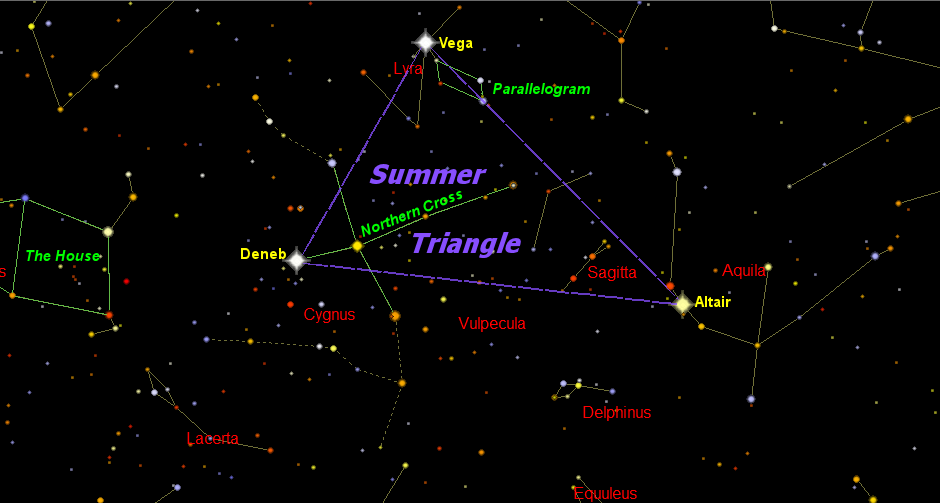
Read Next
Night sky map for july 2024: the summer triangle, see 7 stars and planets in 5 minutes, see the milky way galaxy from earth: october is the best time, 2. look straight up in july.
Its high-up perch is a mere springboard. For those who live near latitude 40° (such as residents of Boston, New York, Denver, Philly, Indianapolis, or San Francisco), Vega is uniquely the only bright star that ascends to within a few degrees of the exact zenith. Straight up. On these summer nights, that happens at 1 AM . Or you can patiently wait for late September, when Vega hovers directly overhead at nightfall.

3. How to Pronounce Vega
Most summer stars are dim and cursed with designations like HDE224334 or Zubeneschamali. Only a handful are brilliant and have popular names. Boasting the shortest name of any brilliant star, Vega is nonetheless routinely mispronounced as VAY -ga. That’s because few know this phonetics tip: star names are simple transliterations from their original language. They should be spoken as spelled. Orion’s brilliant foot is Rigel, pronounced RYE ‘jl and Vega is really VEE -guh . No need to add a latin twist with VAY -ga and make it into a cigar or a Chevy. Originally it was WEE -ga, coming from an old Arabic word meaning a falling eagle. Indeed, in my antique astronomy books from the 18th century, the star is listed as Wega.
4. A Vegetarian Star?
People who eschew all animal foods call themselves Vegans, a term probably coined in the 1940s. But their ancestors were not Vegans who hailed from Vega, with its non-vegetarian “eagle” name. Despite being encircled by a dusty disk whose infrared signature has been interpreted as evidence of a planetary system, actual life is implausible there because of the star’s youth.
5. Vega Folklore
Interestingly, there’s a story about Vega and Altair. A number of Asian cultures have folklore surrounding these two stars, which is often some variation of the following: A celestial goddess falls in love with a mere mortal, but the goddess’ father forbids their union and it is doomed. However, the gods take pity and place the two lovers in the sky as Vega and Altair. Separated by a celestial river, the Milky Way, these star-crossed lovers are only allowed to reunite once year. They cross a bridge of magpies across the Milky Way on the 7th night of the 7th Moon.
Vega is also called the Harp Star since it’s in the constellation of Lyra, the Harp. According to Greek myth, the musician Orpheus played the harp to entrance both god and moral.

6. Vega is How We Measure Brightness
Shining at a steady magnitude zero, Vega serves as the “standard candle” used by the worldwide astronomical community to calibrate the brightness of everything else in the universe. Like the French bar of platinum that defined the meter until recently, Vega is the sky’s reference point for the magnitude system.
It’s an ideal choice because it displays not the slightest flickering or unsteady habit; it’s also a single star like our Sun, instead of a binary like most. Its brilliance, equal to 58 suns, emanates from a dazzling 2.7 million-mile-in-diameter ball with a surface of nearly pure hydrogen, floating at the relatively nearby perch of 25 lightyears.
7. Why is Vega So Bright?
Vega is more than 40 times brighter than our Sun! It’s twice the size and mass of the Sun. And it’s fairly close to Earth (for a star)—just 25 light-years away. Its nearness is the main reason why Vega is so bright.
8. Why is Vega Blue?
Why is Vega blueish in color? Its surface temperature is nearly 17,000 degrees Fahrenheit, making it about 7,000 degrees hotter than our Sun.
9. The North Star of Past and Future
Vega is not as normal as we once thought. In 1994, a team of Canadian astronomers announced that Vega has unsuspected peculiarities. It spins much faster than anyone imagined, in a giddy 11 hours compared to 25 days for our own Sun. And its pole of rotation is pointed straight toward us, give or take five degrees. For any Vegans looking skyward, our Sun is its north star!
Twelve thousand years from now, we’ll return the favor. Vega periodically becomes our own pole star as Earth’s axis wobbles through its 26-millennium precession. Brightest of all north stars through the eons, it nonetheless misses the celestial pole by four degrees, making it nearly ten times less precise than the current one, Polaris.
10. Earth is Traveling Towards Vega!
As if this weren’t enough to keep us interested, Vega marks the approximate direction toward which we travel in space. As our entire starry neighborhood participates in the galaxy’s grand rotation, we do a little nine mile-per-second sideslip in Vega’s direction. Those who mistakenly think that the whole universe races away from us might take a glance overhead. In a cosmos where the redshift is as common as pizza, this diamond at the zenith displays the much rarer blueshift.
So enjoy Vega right now as it hovers overhead near the zenith. But no need to rush. Vega will only grow brighter as it heads our way, keeping our descendants company through the eons.
→ See our Star Map with Vega and the Summer Triangle .

ADVERTISEMENT

Mysteries in the Summer Night Sky

Night Sky for September 2023: Planets, Stars, and the Moon

What Star is Directly Overhead?
And Vega kisses the horizon at midnight of Dec 31 when seen from Stonehenge and Nebra, when people around the world kiss as part of New Year's celebrations.
Any know if that print is for sale. Love it. Great article as well.
Fascinating article! Informative, and, fun!!
Another excellent article Bob. Both informative and fun! Great to share with family and friends. I love ancient folklore Bob shares. Thank you!

- Brightest Stars
- Nearest Stars
- Largest Stars
- Types of Stars
- Life Cycle of a Star
- List of Stars
- 2023-11-05 2023-11-05
Vega, Alpha Lyrae (α Lyr), is a bright white main sequence star located 25.04 light-years from Earth in the northern constellation Lyra . With an apparent magnitude of 0.026, it is the fifth brightest star in the sky, after Sirius , Canopus , Alpha Centauri and Arcturus . Vega is the second brightest star in the northern celestial hemisphere. It is only slightly fainter than Arcturus and just outshines Capella .
Vega has the spectral classification A0V, indicating a white star on the main sequence, still fusing hydrogen into helium in its core. The star has a mass of 2.135 solar masses and a radius between 2.362 and 2.818 times that of the Sun. With a surface temperature of 9,602 K, it shines with 40.12 solar luminosities. Vega is a relatively young star, with an estimated age of about 455 million years.
Even though Vega is only about a tenth the age of the Sun, having twice the Sun’s mass means that it will live only a tenth of the Sun’s lifetime. These days, Vega is close to the midpoint of its life cycle . It will become an M-type red giant in about 500 million years, after it stops fusing hydrogen in its core.
Eventually, the bright star will lose most of its mass and end its life as a white dwarf. In the late red giant stage, it will cast away its outer gaseous envelope to form a planetary nebula. The clouds of gas ejected from the star will glow until they dissipate into the surrounding space and the dense stellar remnant will gradually cool and fade.
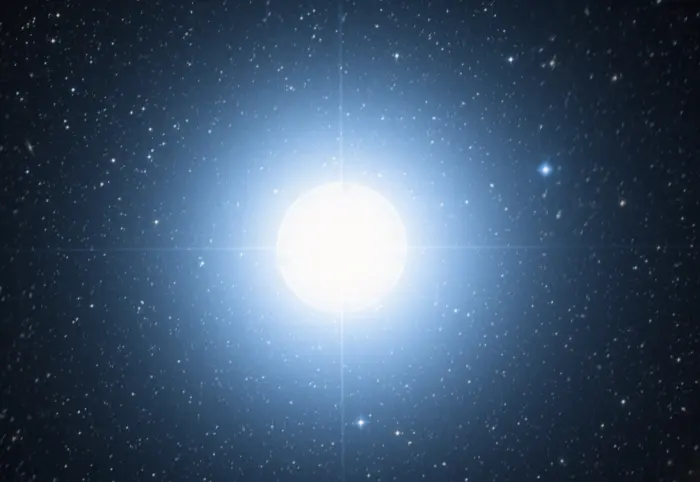
Vega (Alpha Lyrae), image: Wikimedia Commons/Morigan221 (CC BY-SA 3.0)
Vega is a suspected Delta Scuti variable star, one whose variations in luminosity result from both radial and non-radial pulsations of its surface. Vega exhibits both radial and non-radial pulsations. Some parts of its surface contract while others simultaneously expand (non-radial pulsations), and the star also contracts and expands by changing its radius to maintain its spherical shape (radial pulsations).
Also known as dwarf Cepheids, Delta Scuti variables are commonly used as standard candles to establish distances to open and globular star clusters, galaxies, and the Galactic centre. Other bright stars in this class include Altair in the constellation Aquila , Denebola and Zosma in Leo , Caph in Cassiopeia , Tureis in Puppis , Seginus in Boötes , and Polaris Australis (the South Star) in Octans .
Vega completes a full rotation around its axis every 12.5 hours. For comparison, the Sun takes just over 25 days even though it is considerably smaller. Vega spins with an exceptionally high rotational velocity – estimates are as high as 236.2 ± 3.7 km/s along the equator – and, as a result, it is flattened at the poles and has an extended equator.
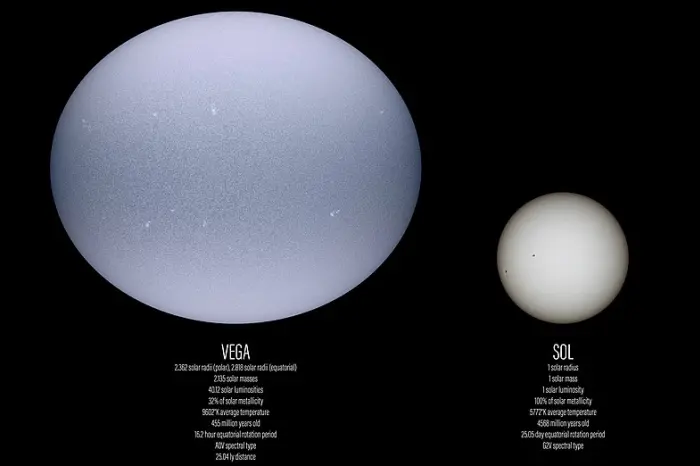
The fifth brightest star, Vega, compared with the Sun (including granulation, gravity darkening, oblateness and bright starspots detected in a 2015 paper. Image credit: Matúš Motlo (CC BY-SA 4.0)
The high spin rate gives Vega the shape of an oblate spheroid. The star’s equatorial diameter is 19% larger than its polar diameter. Vega’s equatorial bulge cannot be observed directly because we only get a pole-on view.
If we could see Vega from its equatorial plane, its spectrum would be about half as luminous because the temperature is lower at the equator than at the poles due to a phenomenon known as gravity darkening. The poles are hotter because they are closer to the centre of mass, while the equatorial region is colder because it is further away from the star’s core.
Gravity at the equator is also weaker than at the poles because the centre of mass is further away. Gravity affects the amount of energy the star radiates and, as a result, there is a significant difference in surface temperature between the poles and the equator. The temperature at the poles is about 17,900° F, while the equatorial surface temperature is only 13,800° F. The poles are said to be “gravity brightened,” while the equator is “gravity darkened.” Achernar , the brightest star in the constellation Eridanus , Altair in Aquila , and Regulus in Leo are other examples of this.
Some of Vega’s light at the equator is blocked by a circumstellar debris ring. Debris disks are sites where planets and planetary systems form. However, no planets have been confirmed around Vega to date. Even if they exist, the star’s short life span makes it unlikely that any complex form of life could develop there.
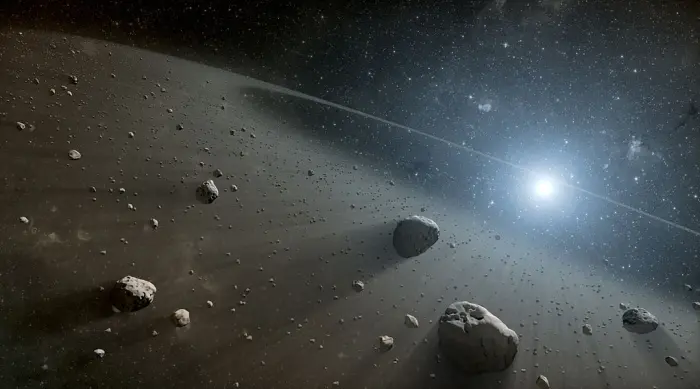
This artist’s concept illustrates an asteroid belt around the bright star Vega. Evidence for this warm ring of debris was found using NASA’s Spitzer Space Telescope, and the European Space Agency’s Herschel Space Observatory, in which NASA plays an important role. Image credit: NASA/JPL-Caltech
In 2013, a team of astronomers led by Kate Su at Steward Observatory at the University of Arizona discovered a large asteroid belt in the Vega system. The discovery makes Vega even more similar to Fomalhaut than previously known.
Like Vega, Fomalhaut lies about 25 light-years away. It is an A-type main sequence star slightly smaller than Vega, with a mass of 1.92 solar masses and a radius of 1.842 solar radii. It has an estimated age of 440 million years. Both Fomalhaut and Vega were once believed to be members of the Castor Moving Group, a disputed stellar association that also included Castor in the constellation Gemini , Alderamin in Cepheus , and Zubenelgenubi in Libra .
Both stars have warm inner belts and cool, comet-filled outer belts that resemble the asteroid and Kuiper belts in the solar system. Fomalhaut ’s debris disk was imaged by the James Webb Space Telescope (JWST) in 2023. The wide gap between the debris belts indicates that both stars host multiple planets, which have yet to be detected. The temperature of the inner belt around Vega was measured to be minus 190 degrees Fahrenheit and that of the outer belt, minus 370 degrees.
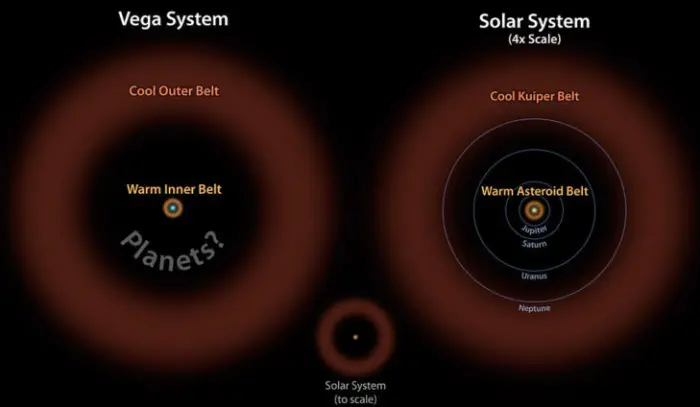
Astronomers have discovered what appears to be a large asteroid belt around the bright star Vega, as illustrated here at left in brown. The ring of warm, rocky debris was detected using NASA’s Spitzer Space Telescope, and the European Space Agency’s Herschel Space Observatory, in which NASA plays an important role. In this diagram, the Vega system, which was already known to have a cooler outer belt of comets (orange), is compared to our solar system with its asteroid and Kuiper belts. The relative size of our solar system compared to Vega is illustrated by the small drawing in the middle. On the right, our solar system is scaled up four times. The comparison illustrates that both systems have inner and outer belts with similar proportions. The gap between the inner and outer debris belts in both systems works out to a ratio of about 1-to-10, with the outer belt 10 times farther away from its host star than the inner belt. Astronomers think that the gap in the Vega system may be filled with planets, as is the case in our solar system. Image: NASA/JPL-Caltech
Planet search
In 1997, the James Clerk Maxwell Telescope discovered a bright central region about 9’’ northeast of Vega. The region appeared as an irregularity in the star’s dust disk. Astronomers have hypothesized that it indicated the presence of a planet. In 2005, they narrowed down the size of the hypothetical planet to 5-10 times the mass of Jupiter.
However, two years later, observations with the Plateau de Bure Interferometer revealed a smooth and symmetric debris disk, without any evidence of the previously reported irregularities. Observations with the Herschel Space Telescope in 2012 confirmed the smooth structure of the disk. Even though there is no evidence of a massive planet, there still may be smaller planets orbiting Vega at a closer distance, where they are more difficult to detect.
A 2021 study reported the detection of a candidate Jovian planet with an orbital period of 2.43 days. The study authors analyzed over 1,500 spectra of Vega taken over 10 years to find periodic radial velocity variations, and they discovered the candidate radial velocity signal. If the planet exists, it has a minimum mass of around 20 Earth masses. The researchers detected another candidate signal that might indicate the presence of a Saturn-mass planet with an orbital period of about 200 days.
Vega forms the Summer Triangle , one of the brightest and largest asterisms in the night sky with Deneb in the constellation Cygnus and Altair in Aquila . The three stars dominate the evening sky during the northern hemisphere summer. They are easy to identify. Vega appears next to a faint parallelogram that outlines the celestial Harp, Deneb marks the top of the Northern Cross , and Altair is flanked by two other relatively bright stars, Tarazed and Alshain . For northern observers, the Summer Triangle appears high overhead during the summer months.
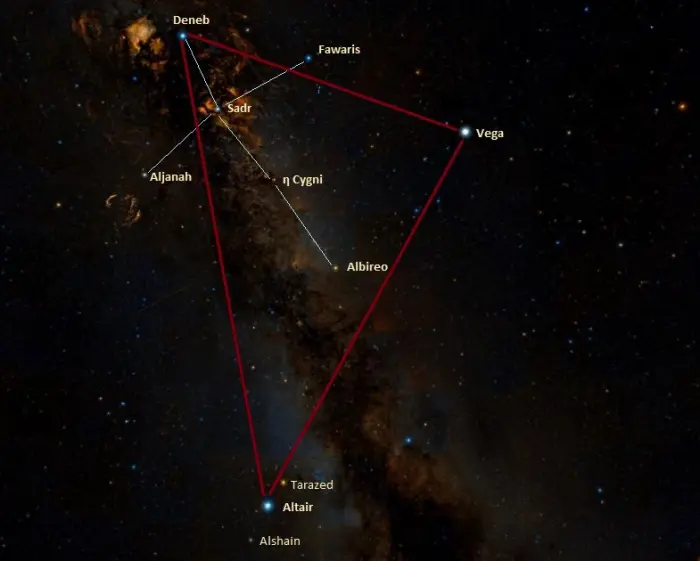
The Summer Triangle and the Northern Cross, image: Wikisky
Vega’s proximity and brightness have made the star a frequent object of study. Vega was one of the first stars to have its distance measured using parallax and the first star outside our solar system to be photographed. It was also the first star to have its spectrum measured.
Vega was first photographed using a 15-inch refractor telescope and the daguerreotype process on July 17, 1850 by William Bond and John Adams Whipple at the Harvard College Observatory. The star’s spectrum was first imaged by amateur astronomer Henry Draper in August 1872. Draper was the first to reveal absorption lines in a star’s spectrum.

The first telescope of the Harvard College Observatory (HCO), “The Great Refractor” was installed in 1847. That telescope was the largest in the United States from its installation until 1867. With it, the first daguerreotype ever made of a star, the bright Vega, was taken by John A. Whipple working under W.C. Bond, following several years of experiments using smaller telescopes. Image credit: John Adams Whipple, 1850
The German-Russian astronomer Friedrich Georg Wilhelm von Struve was the first to measure Vega’s parallax. He gave a value of 0.125 arcseconds, but later revised it, almost doubling the original estimate, after German astronomer and physicist Friedrich Bessel had expressed doubts regarding the data. Struve’s original result was closer to the currently accepted number of 0.129’’, as measured by the Hipparcos satellite. However, as a result of Struve’s revision, it was Bessel who was credited for publishing the first stellar parallax (0.314’’ for 61 Cygni).
Vega is used as a zero point for the colour index, the numerical expression that determines the colour of an astronomical object. Stars that are hotter and bluer than Vega have a smaller colour index, while those that are redder and cooler have a larger one. Vega’s U-B and B-V colour index is set at 0.00.
Vega’s brightness is still used to define zero magnitude for the visible and near infrared parts of the spectrum, with small adjustments. The zero point was originally established by assigning Polaris a magnitude of 2.00, but once astronomers discovered that the North Star was variable, they settled on Vega as the reference star. This is why the Sun, the four other stars that are brighter than Vega – Sirius , Canopus , Alpha Centauri and Arcturus – as well as the planets Venus, Mars and Jupiter, have negative magnitudes.
From Earth, Vega is seen from the direction of one of its poles. For this reason, its projected rotational velocity is much lower (just above 20 km/s) than the more recent measurements indicate. The star is in fact a very fast spinner, rotating at about 90% of its breakup velocity, with estimates of its rotation velocity as high as 236.2 km/s at the equator.
An observer on a hypothetical planet orbiting Vega would see the Sun as a star with a visual magnitude of 4.3 located in the constellation Columba , the Dove.
Vega’s variability was detected in the 1930s, when photometric measurements revealed changes in its brightness on the order of ±0.03 magnitudes. Measurements in 1981 indicated low-amplitude pulsations characteristic of a Delta Scuti-type star.
In 1979, observations with an X-ray telescope revealed that Vega was an X-ray emitter. At the time, Vega was the only main sequence star beyond the Sun known to be an X-ray source.
In 1983, the Infrared Astronomical Satellite (IRAS) detected an excess of infrared radiation coming from Vega. This indicated the presence of a circumstellar disk of dust. Vega was the first star known to have one. The disk extends for hundreds of astronomical units. High-resolution images of the dust were produced by NASA’s Spitzer Space Telescope in 2005. Observations with the Palomar Testbed Interferometer in 2001, the CHARA array in 2006, and the Infrared Optical Telescope Array in 2011 showed evidence of an inner dust band around the star.
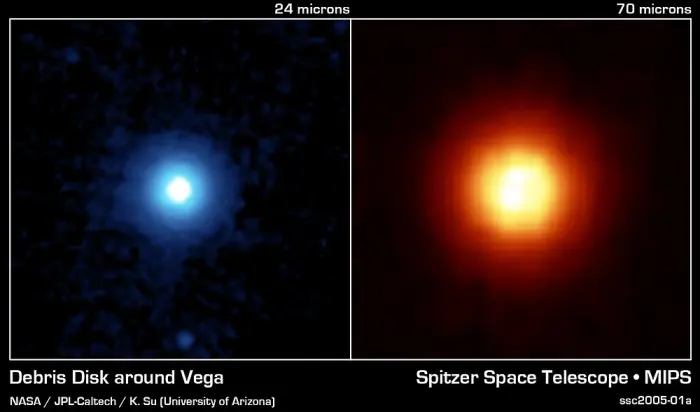
This side-by-side comparison, taken by Spitzer’s multiband imaging photometer, shows the warm infrared glows from dust particles orbiting the star at wavelengths of 24 microns (on the left in blue) and 70 microns (on the right in red). Both images show a very large, circular and smooth debris disk. The disk radius extends to at least 815 astronomical units. (One astronomical unit is the distance from Earth to the Sun, which is 150-million kilometers or 93-million miles). Scientists compared the surface brightness of the disk in the infrared wavelengths to determine the temperature distribution of the disk and then refer the corresponding particle size in the disk. Most of the particles in the disk are only a few microns in size, or 100 times smaller than a grain of Earth sand. These fine dust particles originate from collisions of embryonic planets near the star at a radius of approximately 90 astronomical units, and are then blown away by Vega’s intense radiation. The mass and short lifetime of these small particles indicate that the disk detected by Spitzer is the aftermath of a large and relatively recent collision, involving bodies perhaps as big as the planet Pluto. The images are 3 arcminutes on each side. North is oriented upward and east is to the left. Image: NASA/JPL-Caltech/K. Su (University of Arizona)
Vega was also the first class A star (that is not Ap chemically peculiar) known to have a magnetic field. In 2015, it became the first normal class A star known to have star spots on its surface.
Vega has an unusually low metallicity and observations suggest that it is a weak Lambda Boötis star, a chemically peculiar star with a very low abundance of iron peak elements in its surface layers. There is no clear explanation for the existence of such stars.
Vega’s proper motion is slowly taking the star toward Earth. The star will make its closest approach in about 264,000 years, when it comes within 13.2 light years (4.04 parsecs) of the Sun. Around the year 210000 CE, Vega will take over from Sirius as the brightest star in the sky. It will lie at a distance of 17.2 light years and shine at magnitude -0.81.
Vega is one of the 58 bright stars that have been given a special status in the field of celestial navigation. Navigational stars are some of the brightest and most recognizable stars in the sky. Polaris , Deneb and Altair also belong to this group.
Vega was the North Pole star – the nearest visible star to the north celestial pole – around 12000 BCE and will be again around 13700 CE, when precession of the equinoxes takes it within 5° of true north. It was and will be the Earth’s brightest North Star. Polaris (Alpha Ursae Minoris), the current North Star, is only the 48th brightest star in the sky.
Vega is associated with the Lyrids , a meteor shower that can be seen from April 16 to April 26 each year. The shower peaks around April 22 with 5 to 10 meteors per hour. The radiant of the Lyrid meteor shower is located near the star and the meteors appear to come from Vega’s direction, but this is just a line-of-sight coincidence. The true source of the meteor shower is the long-period Comet C/1861 G1 Thatcher. The particles of dust left behind by the comet that burn up in the Earth’s atmosphere are only about 100 km away.
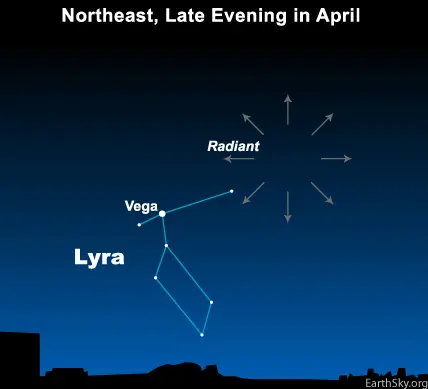
The radiant point of the Lyrid meteor shower, image credit: Bruce McClure and Joni Hall, EarthSky.org (CC BY-SA 3.0)
In medieval astrology, Vega was considered one of the 15 Behenian fixed stars. These stars were believed to be a source of astrological power for one or more planets and considered useful for magical applications. Vega was associated with Mercury and Venus and linked to winter savory and chrysolite. Astrologers believed that it gave artistic talent, aspirations for status and influence, high success, refinement, and a tendency for debauchery.
Like most exceptionally bright stars, Vega has been used or referenced in countless works of fiction. The best-known uses and mentions include Foundation (1951) by Isaac Asimov, Alfred Bester’s The Stars My Destination (1956), Robert A. Heinlein’s Have Space Suit – Will Travel (1958), Roger Zelazny’s This Immortal (1966), Carl Sagan’s Contact (1985), Dan Simmons’ Hyperion (1989) and The Fall of Hyperion (1990), and Greg Egan’s Diaspora (1997).
The name Vega (once also spelled Wega) derives from the Arabic wāqi‘ , which means “falling” or “landing.” It was taken from the phrase an-nasr al-wāqi‘ , meaning “the swooping eagle” or “the falling eagle.” The name was officially approved for Alpha Lyrae by the International Astronomical Union’s (IAU) Working Group on Star Names (WGSN) on June 30, 2016.
The star’s Arabic name appeared in Egyptian astronomer Mohammad Al Achsasi Al Mouakket’s star catalogue, written circa 1650, and was later translated into Latin as Vultur Cadens, meaning “the falling eagle (or vulture).” Lyra constellation was depicted as a vulture by ancient Egyptians and was similarly represented as a vulture or eagle in ancient India.
In the western world, the name appeared in the Alfonsine Tables , compiled in Spain in the mid-13th century. Medieval astrolabes (inclinometers used to measure stars’ altitude above the horizon) in Europe depicted the star as a bird and called it Wega or Alvaca.
The Chinese name for Vega is the First Star of Weaving Girl (織女一). It refers to the asterism known as the Weaving Girl, formed by Vega with Epsilon Lyrae and Zeta 1 Lyrae.
In Chinese lore, Vega and Altair are associated with the myth of Qixi ( Qi means “seven” and Xi means “night”) and the Qixi Festival (Seventh Evening Festival). The festival is traditionally held on the seventh day of the seventh month on the Chinese lunar calendar to celebrate the annual meeting of Niulang (the cowherd, represented by Altair ) and Zhinü (the weaver girl, represented by Vega). In the story, the two lovers are separated by a large river, represented the Milky Way, and can only meet once a year, when magpies create a bridge across the celestial river so that the lovers can briefly be together again.
The legend is more than 2,600 years old. It also inspired the Tanabata festival in Japan and the Chilseok festival in Korea. The Tanabata festival celebrates the meeting of Orihime (Vega) and Hikoboshi ( Altair ), while the Korean event is associated with the folktale of Jiknyeo (the weaver girl) and Gyeonwu (the herder).
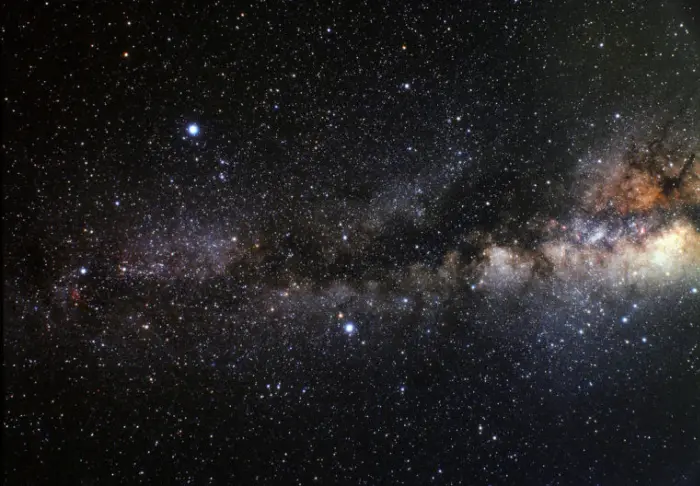
The Summer Triangle with Vega (top left), Altair (lower middle) and Deneb (far left), image: NASA, ESA. Credit: A. Fujii
To the ancient Greeks, Vega symbolized the handle of Orpheus’ harp, while the Romans based the start of the autumn season on the hour of the star’s falling below the horizon. Assyrians called the star Dayan-same , meaning “the judge of heaven,” and Akkadians knew it as Tir-anna , or “life of heaven”.
In ancient Babylonian culture, Vega may have been one of the stars known as Dilgan , or “the messenger of light.” In Hindu mythology, the star is known as Abhijit , meaning “the victorious one” or “the undefeatable one.” In the Mahabharata, Krishna says that he was born under this nakshatra (lunar mansion associated with the star).
In northern Polynesia, Vega was known as whetu o te tau , which means “the year star”. It once marked the beginning of the new year, before the function was assigned to the Pleiades cluster.
In northwestern Victoria in Australia, the Boorong people called Vega Neilloan , or “the flying loan,” referring to the ground-dwelling Australian malleefowl. The Lyrids represented the scratchings of the malleefowl during the nest-building season.
Vega is relatively easy to find because it marks the northwestern vertex of the Summer Triangle , a bright, large asterism that dominates the evening sky during the northern hemisphere summer. The other two stars that form the asterism are Deneb , the brightest star in Cygnus , the Swan, and Altair , the brightest star in Aquila , the Eagle, located opposite Cygnus.
Vega is part of the recognizable constellation figure of Lyra . It appears next to a small parallelogram formed by Sheliak , Sulafat , Delta and Zeta Lyrae, which lies between Vega and Albireo at the Swan ’s beak. Sheliak and Sulafat (Beta and Gamma Lyrae) can be used to find the Ring Nebula (Messier 57), a bright planetary nebula in Lyra.
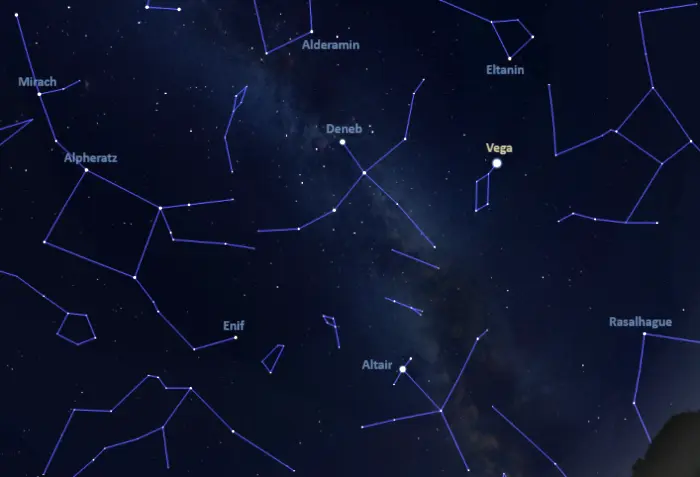
Vega location, image: Stellarium
Vega is circumpolar and can be seen throughout the year from locations north of the latitude 51°N. It is visible from all locations north of the latitude 51°S. From the mid-northern latitudes, the star can be seen near the zenith in the evening during the northern hemisphere summer, while observers in the mid-southern latitudes can see it low above the northern horizon during the southern hemisphere winter.
Constellation
Vega is located in the constellation Lyra . Lyra is a relatively small constellation, sandwiched between the larger Cygnus and Hercules. Vega stands out in this part of the sky as the brightest of the stars that form the constellation’s distinctive lyre-shaped asterism. Sulafat , Lyra’s second brightest star, is considerably fainter, with a visual magnitude of 3.261.
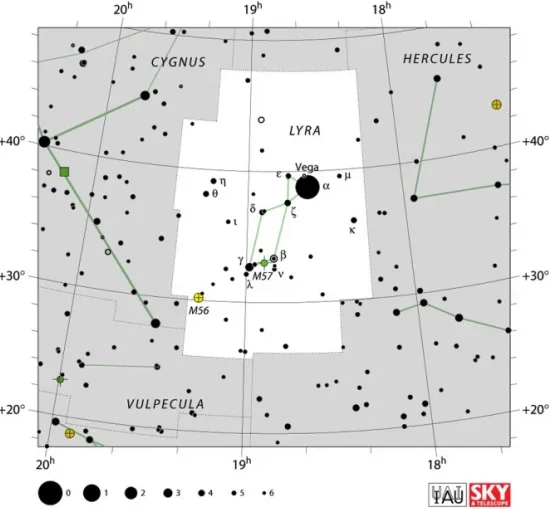
Lyra constellation map by IAU and Sky&Telescope magazine
In Greek mythology, Lyra represents the lyre of the mythical Greek musician and poet Orpheus. The constellation is a popular telescope target because, despite its size, it contains several interesting stars and deep sky objects. Notable stars in the constellation include the variable stars Beta Lyrae, R Lyrae and RR Lyrae, the visual double Delta Lyrae, and the multiple star system Epsilon Lyrae , popularly known as the Double Double.
Interesting deep sky objects in Lyra include the planetary nebula Messier 57 (the Ring Nebula), the bright globular cluster Messier 56 , the open cluster NGC 6791 and the interacting triplet of galaxies designated as NGC 6745.
The best time of the year to see the stars and deep sky objects in Lyra is during the month of August, when the constellation is high overhead in the evening for northern observers. The entire constellation is visible from locations north of the latitude 40° S.
The 10 brightest stars in Lyra are Vega (Alpha Lyrae, mag. 0.026), Sulafat (Gamma Lyrae, mag. 3.261), Sheliak (Beta Lyrae A, mag. 3.52), R Lyrae (mag. 4.00), Delta 2 Lyrae (mag. 4.22), Kappa Lyrae (mag. 4.35), Zeta 1 Lyrae (mag. 4.34), Theta Lyrae (mag. 4.347), Aladfar (Eta Lyrae, mag. 4.40), and Epsilon 2 Lyrae A (mag. 4.59).
Vega – Alpha Lyrae
How long would it take by spaceship to reach the vega star?
That depends on how fast your spaceship can travel, and what kind of a route you follow.
Spacecraft never travel in straight lines. But if you could do that, and if you kicked it up to,
let's say, a million miles an hour, then you'd pass the moon in 14 minutes (it took the Apollo
missions 3 days), and you'd be at Vega in only 16,970 years !
Anonymous ∙
Traveling at the speed of light, it would take approximately 25 years to reach the Vega star, which is about 25 light-years away from Earth. However, with current technology, it would take many thousands of years to travel that distance in a spaceship.
Pretty close; Vega is only 25 light-years away.
It takes light from Vega or Alpha Lyrae 25.3 years to get to Earth.
Add your answer:
How long would it take you to reach the nearest star from Earth?
How long will depend on the velocity. The closest star would be 4.24 light years away
How long would it take in the space shuttle to get to the closest star?
If you where at the velocity of 500 mph you would reach the closest star witch is 4.6 light years away it would take (10,650,032) days I hope that helped
How long would it take gamma rays from an exploding star to reach earth?
Gamma rays travel at the speed of light, so it would take approximately 8 minutes for gamma rays from an exploding star to reach Earth since the star is outside our solar system.
Where is the spaceship on furdiburb lite?
use the free postion from the owl, put it in empty hand at the star sis fountion jump on the pool of water and star surf and collect credits till u reach past all the planets and u get one spaceship dnt worry it chrashes or collect 98 squrills got back to owl and got the postion for another spaceship idk tht mite chrash too n need to wait for update or collect squrial first mabey, oh and if u have a 1000 credits get the position form the owl to reach the last planet u fell from. hope this helps x
How long would it take to reach the largest star in your Solar System?
The largest star in our Solar System is the Sun. Since the Sun is about 93 million miles away from Earth and the speed of light is about 186,282 miles per second, it would take about 8 minutes for light (or any object traveling at the speed of light) to reach the Sun from Earth.
How long would it take to reach the star Vega if a spaceship could travel at one-tenth the speed of light?
It would take approximately 40 years to reach the star Vega, which is about 25 light-years away from Earth, if a spaceship could travel at one-tenth the speed of light.
How does a star get into outer space?
through a spaceship get it star celebrity into outer space thorough a spaceship oh whatever
How long would it take to reach that star if you could travel at 25000 mph?
Not sure about "that" star, but it would take about 3700 hours (0.42 years) to reach the sun, our nearest star. The journey to next nearest, Proxima Centauri, would take around 114000 years.
What could help a spaceship get to the nearest star?
In order to get anywhere close to a star you would need some kind of protection from the extreme temperatures whether it be in the form of shields, a new coat of protection around the spaceship (so it wouldn't melt), etc. You would also need protection from the ultraviolet light waves. Also, in terms of fuel, you would either need a lot more or you would need a more efficient fuel to get you there sooner. Either way, it would take many many light-years to reach any star beyond our solar system.
How many years would it take for the Northern Star light to reach Earth?
Polaris (North Star) is about 433 light years from us, so that is how long light will take to reach us.
How long would it take the light from a star 72 light year away from earth to reach the earth?
Easy answer: it would take 72 years.
How long would it take to go from sun to the farthest planet in the fastest spaceship?
We don't know where the farthest planet is. But if we assume it's at the edge of the observable universe, then it depends on how fast we go:A spaceship travelling as fast as we can go in 2017 would take 838 trillion years.A spaceship travelling at the speed of light (which is virtually impossible) would take 45 billion years.A star trek Starship travelling at variable warp speeds would take about 45 million years
What is the name of Nero's spaceship in the new Star Trek movie?
Top Categories


IMAGES
VIDEO
COMMENTS
Vega Star Travel, Hammam Sousse. 7,551 likes · 12 talking about this · 41 were here. Avec Vega Star Travel Large choix des hôtels et des voyages : La meilleure qualité aux meilleurs prix
Vega is the brightest star in the northern constellation of Lyra.It has the Bayer designation α Lyrae, which is Latinised to Alpha Lyrae and abbreviated Alpha Lyr or α Lyr.This star is relatively close at only 25 light-years (7.7 parsecs) from the Sun, and one of the most luminous stars in the Sun's neighborhood.It is the fifth-brightest star in the night sky, and the second-brightest star ...
published 9 November 2018. Vega is a bright star located just 25 light-years from Earth, visible in the summer sky of the Northern Hemisphere. The star is part of the constellation Lyra and, with ...
Vega star color. Vega is a bluish-white star classified as A0V: The letter "A" denotes its surface temperature of about 10,000 K.; The number 0 indicates that it's the hottest among the 10 subclasses in its spectral type.; The letter "V" indicates that it's a main sequence star going through its main phase of life as it fuses hydrogen into helium.
Vega, brightest star in the northern constellation Lyra and fifth brightest in the night sky, with a visual magnitude of 0.03. It is also one of the Sun's closer neighbours, at a distance of about 25 light-years. Vega's spectral type is A (white) and its luminosity class V (main sequence). It will
Promo Spécial AOUT 2021 jusqu'à -40% chez VEGA STAR TRAVEL ⛱ A vous notre sélection d'hôtels avec séjour GRATUIT pour votre enfant. ☑ Profitez-en dès Maintenant, il n'y en aura pas pour tout le...
Blue-white Vega shines brightest of the three stars in the Summer Triangle. It's the brightest star in the east in the evening on July evenings. And it's the brightest light in the ...
The first mention of Vega in an official Western star catalogue was in the Alfonsine Tables of 1215, and in medieval England and Western Europe, Vega was known as either Wega or Alvaca. ... 5 Bizarre Paradoxes Of Time Travel Explained December 20, 2014 58. Top 10 Free Smartphone Apps For Stargazing in 2024 January 10, 2016 5. 20 Recommended ...
Vega Star Travel. a louer appartements S+2 a Folla Chott Mariem Haut standing bord de mer avec les facilités ( plusieurs piscines eau de mer avec des Jacuzzi , restaurants , pizzeria, animation le soir , animation pour les enfants , terrain de foot, centre de spa, ( voir photos ) : prix 2100 dt / Semaine max 5 personnes et disponible seulement ...
Right now, the North Star is Polaris, but Vega was the northern pole star around 12,000 BC and will the pole star again about the 13,727. If you took a long exposure photograph of the northern sky today, the stars would appear as trails around Polaris. When Vega is the pole star, a long exposure photograph would show stars circling it.
Vega is an A-type star, the name for stars that tend to be bigger, younger and much faster-spinning than the Sun. Also known as Alpha Lyra, Gliese 721 and HD 172167, the star is 455 million years old, and has a mass of two solar masses. ... Because of Vega's pole-on orientation, this would correspond to a Jovian planet if the orbit is aligned ...
In 1979, Vega became the first solitary main-sequence star beyond the Sun known to be an X-ray emitter. Later, in 1983 Vega became the first star found to have a disk of dust. Distance, Size, and Mass. Vega is about 25 light-years away from the Sun, and it lies at a vertex of a widely spaced asterism called the Summer Triangle.
Vega Star Travel, Hammam Sousse. 7,558 likes · 9 talking about this · 41 were here. Avec Vega Star Travel Large choix des hôtels et des voyages : La meilleure qualité aux meilleurs prix
1. Vega of The Summer Triangle. Vega is the 5th brightest star visible from Earth, and the 3rd brightest easily visible from mid-northern latitudes, after Sirius and the Arcturus. In the northern sky, it's 2nd brightest after the red giant, Arcturus. Vega is also one of three stars in the famous star pattern called the Summer Triangle, along ...
Vega. Vega, Alpha Lyrae (α Lyr), is a bright white main sequence star located 25.04 light-years from Earth in the northern constellation Lyra. With an apparent magnitude of 0.026, it is the fifth brightest star in the sky, after Sirius, Canopus, Alpha Centauri and Arcturus. Vega is the second brightest star in the northern celestial hemisphere.
عرض ملف vega star travel الشخصي على LinkedIn، أكبر شبكة للمحترفين في العالم. vega star لديه 3 وظيفة مدرجة على ملفهم الشخصي. عرض الملف الشخصي الكامل على LinkedIn واستكشف زملاء vega star والوظائف في الشركات المشابهة
The bright star Vega, which is just 25 light years—or about 150 trillion miles—from Earth might be best known in popular culture as the origin of an extraterrestrial message in the book and Hollywood film Contact.. Researchers have yet to find a single planet in orbit around Vega, but that might be about to change: Drawing on a decade of observations from the ground, a team of scientists ...
Pretty close; Vega is only 25 light-years away. It takes light from Vega or Alpha Lyrae 25.3 years to get to Earth. That depends on how fast your spaceship can travel, and what kind of a route you ...
Vega's lastest cruises, upcoming cruise schedule, 8 ship reviews, and Vega's deck plans, cabin layouts and inclusions. ... 5 Star . 88%. 4 Star . 13%. 3 Star . 2 Star . 1 Star . European Gems 0 Ali and Paula, WA, Australia, May 2024 . ... read more soothing motion of the grand boat Vega. Travel Marvel's staff were fabulous. Nothing was too much ...
Best 3 Star Hotels in Elektrostal on Tripadvisor: Find 42 traveller reviews, 19 candid photos, and prices for three star hotels in Elektrostal, Moscow Oblast, Russia.
Elektrostal is a city in Moscow Oblast, Russia, located 58 kilometers east of Moscow. Elektrostal has about 158,000 residents. Mapcarta, the open map.
A mix of the charming, modern, and tried and true. See all. Apelsin Hotel. 43. from $48/night. Apart Hotel Yantar. 2. from $28/night. Elektrostal Hotel.
View prices for your travel dates. Check In. Mon, Jun 03. Check Out. Tue, Jun 04. Guests. 1 room, 2 adults, 0 children. Contact accommodation for availability. There are similar hotels available. View all. ... 3-Star Hotels in Elektrostal. Popular Elektrostal Categories. Elektrostal Hotels with Banquet hall Elektrostal Hotels with Game room.
Mabilisang pasilip ng mga nagbabagang balita ang hatid ng TV Patrol Express, 5PM, Lunes hanggang Biyernes. Hatid nina Chief of Reporters Jeff Canoy at...